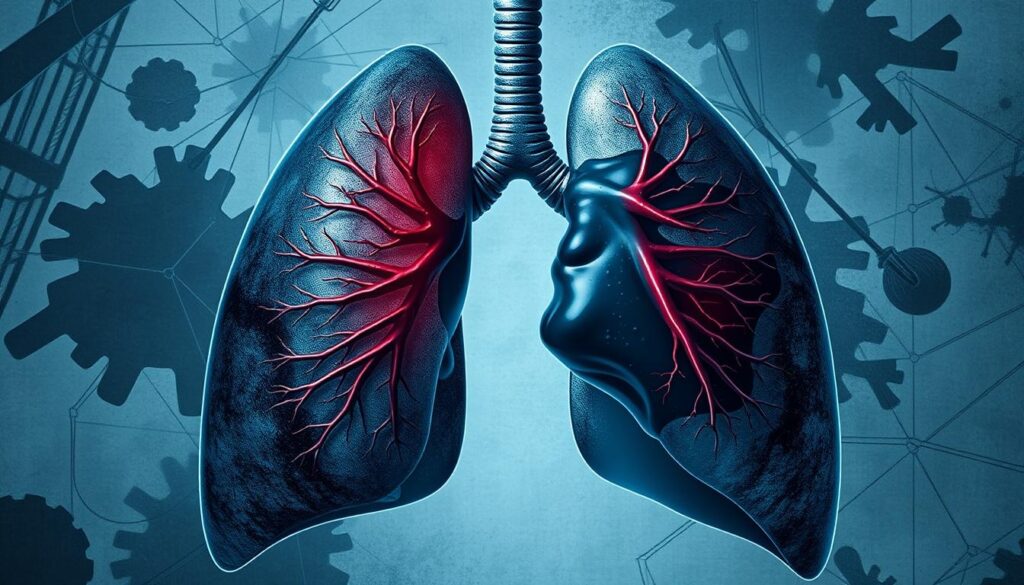Walking pneumonia is a mild lung infection caused by bacteria like Mycoplasma pneumoniae. It’s different from severe pneumonia because it doesn’t stop you from doing daily activities. Knowing the symptoms, treatment, and risks can help in recovery and prevention.
Symptoms include sore throat, mild chills, cough, sneezing, headache, and low-grade fever. It’s hard to diagnose because symptoms are similar to other illnesses. But, early treatment can stop it from getting worse. If you think you or someone has walking pneumonia, see a doctor quickly.
In recent months, the U.S. has seen more walking pneumonia cases. This is especially true for kids aged 2 to 4, making up about 7% of ER visits in early October. Older adults and very young children are at higher risk. It’s important to understand and treat this illness.
Key Takeaways
- Walking pneumonia is a milder form of pneumonia often caused by bacteria like Mycoplasma pneumoniae.
- Symptoms include sore throat, mild chills, cough, sneezing, headache, and low-grade fever.
- Walking pneumonia cases have recently increased, especially among children aged 2 to 4 years old.
- Treatment is crucial for recovery and preventing complications.
- Elderly and very young children are at higher risk.
What Is Walking Pneumonia?
Walking pneumonia, also known as atypical pneumonia, is a milder form of pneumonia. It usually doesn’t need hospital care. It’s often caused by Mycoplasma pneumonia and spreads through the air.
This illness is part of community-acquired pneumonia cases. It can take 4-20 days for symptoms to show up. Unlike severe pneumonia, walking pneumonia is milder.
Causes of Walking Pneumonia
The main cause of walking pneumonia is the Mycoplasma pneumonia bacterium. It damages the respiratory tract lining, causing infections. Other causes include viruses and molds, but Mycoplasma pneumonia is the most common.
People at higher risk include school-aged children and older adults in nursing homes. Also, those in crowded places like schools and military barracks are at risk.
Difference from Severe Pneumonia
Walking pneumonia is different from severe pneumonia. It has less intense symptoms and takes longer to start. Severe pneumonia might need hospital care right away.
Walking pneumonia starts with mild symptoms like chills, cough, and low fever. Most people get better with antibiotics and care without serious problems.
Knowing about atypical pneumonia and its causes helps manage it better. It prevents it from becoming more severe. Keeping community health in mind is key, especially in outbreak-prone areas.
Common Symptoms of Walking Pneumonia
Walking pneumonia is milder than severe pneumonia but can still affect daily life. Knowing the symptoms helps in recognizing and treating it.
Initial Symptoms
The first signs of walking pneumonia are often mild and can be mistaken for a cold or flu. People might feel a sore throat, mild fever, and headache. A runny nose and feeling tired are also common early pneumonia symptoms.
As the infection grows, a persistent cough becomes a key symptom. This cough can last for weeks or months.
Symptoms can differ based on age and health. For example, children might show symptoms in different lung parts, leading to varied signs.
Prolonged Symptoms
Untreated symptoms can worsen and last longer. A persistent cough is common and can last for weeks or months. Ear pain and chest pain can also occur, especially when coughing or taking deep breaths.
Other symptoms include:
- Fatigue
- Headaches
- Chills
- Sore throat
- Malaise
- Joint pain
- Loss of appetite
Symptoms usually start 15-25 days after exposure and worsen over 2-4 days. With antibiotics, most people start feeling better in three to five days. However, the cough can last longer.
It’s important to remember that pneumonia symptoms can vary. Most people with walking pneumonia start to feel better within three to five days of treatment.
Understanding symptoms and their progression is crucial for managing walking pneumonia. It helps address chest pain and other discomforts.
Diagnosis of Walking Pneumonia Cases
Diagnosing walking pneumonia involves looking at symptoms and doing medical tests. Since symptoms can be mild, people might not seek medical help right away. This can cause a delay in pneumonia diagnosis, which is key for treatment.
A doctor will first do a physical exam to check for walking pneumonia. They listen to the lungs and look for symptoms like coughing, fever, and tiredness. To confirm an infection, chest X-rays are often used. These X-rays show lung involvement that might not be seen in a simple exam.
Chest X-rays are very important for spotting lung infections. They are good at finding infections, even if symptoms are mild. They also help find specific bacteria like Mycoplasma pneumoniae, which is common in walking pneumonia. This ensures the right antibiotics are given.
But, walking pneumonia is often not diagnosed because it’s mild. This is a big worry for people with lung diseases or weak immune systems. They are more at risk of serious problems without quick treatment.
Diagnosing pneumonia, especially bacterial types that come after a cold or flu, is complex. It’s important to rule out other conditions like asthma or COPD. A thorough check, using many diagnostic tools, is needed to correctly diagnose walking pneumonia.
In short, quick and accurate diagnosis of pneumonia is crucial. It helps manage walking pneumonia well, prevents serious issues, and ensures patients get the right treatment.
Treatment Options for Walking Pneumonia
Walking pneumonia is a milder form of pneumonia but still needs proper care for full recovery. There are several treatment options, depending on the cause and how severe the symptoms are. We’ll look at two main methods: antibiotics and ways to relieve symptoms.
Antibiotic Treatments
Antibiotics are key when walking pneumonia is caused by bacteria, especially Mycoplasma pneumoniae. The choice of antibiotic depends on the bacteria causing the infection.
It’s crucial to take the antibiotics as directed by a doctor. This ensures the bacteria are fully cleared and helps prevent antibiotic resistance. Common antibiotics for walking pneumonia include azithromycin, doxycycline, and levofloxacin. But remember, antibiotics don’t work against viral pneumonia, so other treatments are needed then.
Symptom Relief
Antibiotics fight the infection, but relieving symptoms is also important. Over-the-counter cough medicines help manage coughing, making it easier to rest. But, it’s good to keep coughing to clear mucus from the lungs.
Fever reducers and pain relievers like aspirin, ibuprofen, and acetaminophen help with fever and pain. These medicines offer a lot of relief, making it easier to handle symptoms while the body heals.
Effective treatment for pneumonia often combines medicine, rest, and staying hydrated. A plan tailored to the person’s age, health, and symptoms helps them recover quickly and smoothly.
| Treatment Aspect | Details |
|---|---|
| Antibiotic Options | Azithromycin, doxycycline, levofloxacin |
| Over-The-Counter Medications | Cough suppressants, fever reducers, pain relievers |
| Other Recommendations | Rest, hydration, completing prescribed medication course |
Understanding Walking Pneumonia Duration
The walking pneumonia duration varies a lot from person to person. Most people start feeling better in three to five days after treatment starts. But, some symptoms like a cough can last for weeks or even months.
This is especially true for people with health issues like asthma or COPD.
The Centers for Disease Control and Prevention (CDC) says walking pneumonia is a big reason for kids to go to the emergency room. It mainly hits school-age kids, teens, and young adults. Symptoms include a cough, fever, chills, and trouble breathing.
Here are some key points about walking pneumonia:
- Without antibiotics, some people get better in 7–10 days, while others take weeks or months.
- Those recovering from viral pneumonia might start feeling better 1–3 weeks after treatment.
- Many people feel tired for about a month, even after they seem to get better.
The recovery time for walking pneumonia depends on many things. These include the person’s health, age, and any other health problems they might have. Doctors say to see a doctor if a cough gets worse after three weeks or if breathing is hard.
Pneumonia Prevention Strategies
Pneumonia is a big health problem, causing over 41,000 deaths in the U.S. in 2022. It’s clear that stopping pneumonia before it starts is key.
Vaccinations
Vaccines are crucial in fighting pneumonia. The flu vaccine is a must as it stops flu-related pneumonia. The pneumococcal vaccine fights off pneumococcus bacteria, recommended for kids under 5 and adults over 65.
It’s also for people aged 5 to 64 with health issues or who smoke. Getting these vaccines can lower pneumonia risk and stop illness spread.

Hygiene Practices
Good hygiene is vital in preventing pneumonia. Washing hands often and using sanitizers can cut down germ spread. Not smoking and drinking less alcohol also help prevent lung infections.
Smoking weakens lung defenses, making quitting a must for pneumonia prevention.
Living a healthy life, with a good diet, exercise, and rest, boosts your immune system. Combining vaccines with hygiene practices is a strong way to fight pneumonia.
| Preventive Measure | Recommendation |
|---|---|
| Flu Vaccine | Annually for everyone |
| Pneumococcal Vaccine | For children under 5, adults 65+, and at-risk individuals aged 5-64 |
| Hand Hygiene | Frequent hand washing or using hand sanitizers |
| Smoking Cessation | Quit smoking and avoid secondhand smoke exposure |
| Healthy Lifestyle | Balanced diet, exercise, and proper rest |
Risk Factors Associated with Walking Pneumonia
It’s important to know the risk factors for walking pneumonia to prevent and manage it. This illness can affect people of all ages, but some are more at risk. Kids under two and adults over sixty-five are especially vulnerable to bacterial infections that can cause walking pneumonia.
People who are immunocompromised are also at a higher risk. This includes those on chemotherapy, with HIV/AIDS, or who have had an organ transplant. Pregnant women and smokers are also at a higher risk of severe pneumonia.
Walking pneumonia spreads easily in close-contact settings and where hygiene is poor. To prevent it, washing hands often and getting vaccinated are key, as the CDC advises. A healthy lifestyle also helps keep the immune system strong, fighting off the illness.
| Risk Factor | Details |
|---|---|
| Age | Children under 2 years, adults over 65 years |
| Hospitalization | Patients with chronic diseases, on ventilator support |
| Immune System | Immunocompromised individuals (chemotherapy, HIV/AIDS, organ transplant) |
| Pregnancy | Increased risk of complications such as premature labor |
| Smoking | Weakened lung defenses |
Understanding and reducing these risk factors is key to fighting walking pneumonia.
Complications of Untreated Walking Pneumonia
Untreated walking pneumonia can cause serious health problems. These issues highlight the need for quick treatment. Without treatment, pneumonia can worsen, asthma symptoms can get worse, and serious conditions like encephalitis and hemolytic anemia can occur. It’s important to catch and treat walking pneumonia early.

Encephalitis is a severe complication that causes brain swelling. It can lead to headaches, confusion, seizures, and even coma. Treating walking pneumonia early can prevent these serious problems.
Hemolytic anemia is another serious issue. It happens when red blood cells break down too fast, causing fatigue, dark urine, and jaundice. This condition needs quick attention to avoid serious health problems.
Getting medical help quickly can also prevent other severe pneumonia complications.
| Complications | Symptoms | Prevention Measures |
|---|---|---|
| Encephalitis | Headaches, confusion, seizures, coma | Early treatment of pneumonia |
| Hemolytic Anemia | Fatigue, dark urine, jaundice | Prompt diagnosis and management |
It’s crucial to treat walking pneumonia early to avoid complications. Monitoring symptoms and getting medical help quickly can greatly improve outcomes. Being proactive and aware is essential for protecting your health.
Conclusion
Walking pneumonia is a less severe form of pneumonia but still a serious respiratory issue. It’s important to know its symptoms, treatment, and how to prevent it. This knowledge helps in recovering quickly and keeping the community healthy.
Recently, more kids aged 2 to 4 have been seen in ERs for pneumonia, especially Mycoplasma. The numbers went from 1% in April 2024 to 7.2% in early October. This shows how crucial early detection and treatment are.
Doctors believe the increase in Mycoplasma cases might be due to higher infection rates and better diagnostic tests. Chest imaging and repeat viral testing are key in finding COVID-19 pneumonia early, even in mild cases.
To help those with walking pneumonia, we need strong screening and surveillance. Knowing how to prevent it, like through vaccinations and good hygiene, helps. This way, we can make our community healthier and more resilient.

